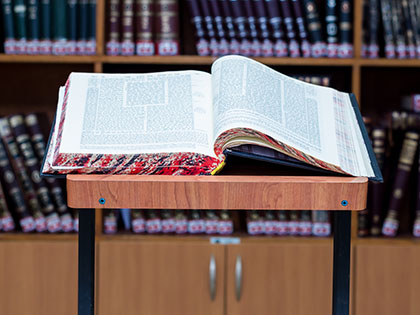
Until the 2nd century C.E., the Oral Torah was passed down in verbal form alone. In the years following the destruction of the Second Temple the fear arose that it would be forgotten. To address this fear, the sages, led by Rabbi Yehudah HaNasi (The Prince), wrote the Oral Torah down in a series of books called the Mishnah. The Mishnah, completed in 188 C.E. was basically an outline and did not include any in-depth analysis or explanation. Consequently, about three hundred years later, the Gemara was composed by other sages, led by Rav Ashi and Ravina. The Gemara contains commentary on the Mishnah. Together the complete collection of Mishnah and Gemara writings make up the Talmud.
There are two versions of the Talmud: Jerusalem and Babylonian. The Babylonian Talmud is the more comprehensive, and is the one usually meant when people refer to ‘the Talmud’. Naturally there are also commentaries on the Talmud by famous scholars including Rashi and Maimonides (the Rambam).
Sections of the Talmud
The Talmud is made up of six sections, called sedarim (orders). Each seder contains several books called mesachot or ‘tracts’ (singular: mesechet).
1. Zera’im (Seeds). This section deals with the laws of agriculture. It also deals with the laws of prayer and blessings. Its 11 mesachot are:
- Berakhot
- Peah
- Demai
- Kilayim
- Shebiit
- Terumot
- Maaserot
- Maaser Sheni
- Challah
- Orlah
- Bikkurim
2. Mo’ed (Season). This section deals with the laws of Shabbat and Yom Tov (holidays). Its 12 mesachot are:
- Shabbat
- Erubin
- Pesachim
- Sheqalim
- Yoma
- Sukkah
- Besah
- Rosh Hashanah
- Taanit
- Megillah
- Moed Qatan
- Hagigah
3. Nashim (Women). This section deals with the laws of marriage and divorce. Its 7 mesachot are:
- Yebamot
- Ketubot
- Nedarim
- Nazir
- Sotah
- Gittin
- Qiddushin
4. Nezikin (Damages). This section deals with civil law, such as laws about damages and theft. It also deals with ethics. Its 10 mesachot are:
- Baba Qamma
- Baba Mesia
- Baba Batra
- Sanhedrin
- Makkot
- Shabuot
- Eduyyot
- Avodah Zarah
- Avot (also known as Pirkei Avot, Ethics of the Fathers)
- Horayot
5. Kedoshim (Holy Things). This section deals with sacrifices. Its 11 mesachot are:
- Zevachim
- Menachot
- Chullin
- Bekhorot
- Arakhin
- Temurah
- Keritot
- Meilah
- Tamid
- Middot
- Qinnim
6. Tohoros (Purities). This section deals with laws of ritual purity. Its 12 mesachot are:
- Kelim
- Ohalot
- Negaim
- Parah
- Tohorot
- Miqvaot
- Niddah
- Makhshirin
- Zabim
- Tebul-Yom
- Yadayim
- Uqsin
Daf Yomi

At the First International Congress of the Agudath Yisrael World Movement in August, 1923, Rav Meir Shapiro of Lublin, Poland, proposed uniting Jews worldwide through the daily study of a page of Talmud. His proposal was well received and Daf Yomi (‘A Daily Page’) commenced its 14th cycle in early 2020 (each cycle takes approximately 7 1/2 years). The completion of each cycle is celebrated publicly (to recognise the significant learning that has taken place), and the popularity of Daf Yomi has increased so much that now over 300,000 people take part in the celebrations at the end of a cycle (at just one venue in New Jersey (USA) for the 2012 celebration, over 30,000 people attended).
Links
- Eliezer Segal: A Page from the Babylonian Talmud
- Aish Crash Course in Jewish History: Talmud
- Judaism 101: Oral Law: the Talmud
- Virtual Jewish Library: The Talmud – Table of Contents
- Chabad: What is the Talmud? Definition and Comprehensive Guide
- Chabad: 21 Talmud Facts Every Jew Should Know


